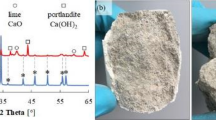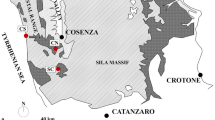Abstract
Changes to physical and mechanical properties of pyroclastic flow deposits occur during welding process, resulting from overburden pressure and temperature. A great deal of research has been carried out to identify which physical parameters can enable quantification of the degree of welding within pyroclastic deposits. Material properties, such as density, porosity, hardness, abrasion, and compressive and flexural strength, are critical in assessing the suitability of natural stone as a building material, but they have not been sufficiently integrated. Therefore, an attempt has been made to develop a welding classification which integrates measurements of material properties with petrographic and textural observations. The proposed classification covers physical, index, and strength parameters for pyroclastic flow deposits. The most important aspect of this investigation has been the quantification of material parameters and definition of a welding classification applicable to a wide range of ignimbrites, from nonwelded to densely welded, that are used as natural building stone. This welding classification is proposed to ensure a consistent approach in characterizing key aspects of welded facies in pyroclastic deposits and in the identification of natural stone reserves.







Similar content being viewed by others
References
ASTM (1983) Standard test method for absorption and bulk specific gravity of natural building stone. ASTM Designation C 97-83, Annual Book of ASTM Standards, West Conshohocken
ASTM (2000) Standard test method for unconfined strength of intact rock core specimens. ASTM Standard D2938-95. Annual Book of ASTM Standards, West Conshohocken
ASTM (2001) Practice for preparing rock core specimens and determining dimensional and shape tolerances 2 D 4543-01. Annual Book of ASTM Standards, West Conshohocken
ASTM (2002a) Standard test method for laboratory determination of pulse velocities and ultrasonic elastic constants of rock. ASTM Standard D2845- 83. American Society for Testing and Materials, West Conshohocken, PA
ASTM (2002b) Standard test method for determination of rock hardness by rebound hammer method. ASTM Standard 04.09 (D5873-00). American Society for Testing and Materials, West Conshohocken
ASTM (2018) Standard test method for flexural strength of dimension stone, ASTM C880 / C880M-18, ASTM International, West Conshohocken, PA, 2018
Bachmann O, Dungan MA, Lipman PW (2002) The Fish Canyon magma body, San Juan Volcanic Field, Colorado: rejuvenation and eruption of an upper crustal batholith. J Petrol 43:1469–1503
Bakış A (2016) Usability of Ahlat stone in rigid pavement construction. Bitlis Eren Univ J Sci 5(2):164–171
Calcaterra D, Cappelletti P, Langella A, Colella A, Gennaro M (2004) The ornamental stones of Caserta province: the Campanian ignimbrite in the medieval architecture of Casertavecchia. J Cult Herit 5:137–148
Dávila Harris P, Ellis BS, Branney MJ, Carrasco-Núñez G (2013) Lithostratigraphic analysis and geochemistry of a vitric spatter-bearing ignimbrite: the Quaternary Adeje Formation, Cañadas Volcano, Tenerife. Bull Volcanol 75:722
Del Porto R, Hurlimann MA (2008) A comparison of different indirect techniques to evaluate volcanic intact rock strength. Rock Mech Rock Eng 42:931–938
Geological Society of London (1977) The description of rock masses for engineering purposes: report by the geological society engineering group working party. Q J Eng Geol 10, Great Britain:355–388
Gokceoglu C, Aksoy H (2000) New approaches to the characterization of clay-bearing, densely jointed and weak rock masses. Eng Geo 58:1–23
Hatipoğlu O (2014) Stone ornaments of Usta Şagird tomb. ASOS J Acad Soc Sci 2(2014):121–132
Heiken G (2006) Tuffs-their properties, uses, hydrology and resources. Geological Society of America, Special Publication, 408, Boulder, pp 127
Hoek E, Brown ET (1980) Underground excavations in rock. Inst. Min. & Metall, London 527 pp
Işik E, Bakiş A, Akilli A, Hattatoğlu F (2015) Usability of Ahlat stone as aggregate in reactive powder concrete. Int J Appl Sci Eng Res 4(4):507–514
ISRM (2007) The complete ISRM suggested methods for rock characterization, testing and monitoring: 1974-2006. In: Ulusay R, Hudson JA (Eds). ISRM Turkish National Group, Ankara, p 628
Karaoğlu Ö, Özdemir Y, Tolluoğlu AÜ, Karabiyikoğlu M, Köse O, Froger JL (2005) Stratigraphy of the volcanic products around Nemrut Caldera: implications for reconstruction of the caldera formation. Turk J Earth Sci 14:123–143
Koralay T, Özkul M, Kumsar H, Çelik SB, Pektaş K (2011) The effect of welding degree on geotechnical properties of an ignimbrite flow unit: the Bitlis Castle case (eastern Turkey). Environ Earth Sci 64(3):869–881
Korkanç M (2007) The effect of geomechanical properties of ignimbrites on their usage as building stone: Nevsehir stone. J Geol Eng 31(1):49–60
Le Bas MJ, Le Maitre RW, Streckeisen A, Zanettin B (1986) A chemical classification of volcanic rocks based on the total alkali–silica diagram. J Petrol 27:745–750
Li X, Rupert G, Summers DA, Santi P, Liu D (2000) Analysis of impact hammer rebound to estimate rock drillability. Rock Mech Rock Eng 33:1–13
Öner F, Turkmen S, Özbek A, Karakaya T (2006) Engineering properties of Hınıs ignimbrites and their usability as a building stone (Erzurum, Turkey). Environ Geol 50(2):275–284
Özdemir Y, Karoğlu Ö, Tolluoğlu AÜ, Güleç N (2006) Volcanostratigraphy and petrogenesis of the Nemrut stratovolcano (East Anatolian High Plateau): the most recent post-collisional volcanism in Turkey. Chem Geol 226:189–211
Özvan A, Dinçer İ, Akın M, Oyan V, Tapan M (2015) Experimental studies on ignimbrite and the effect of lichens and capillarity on the deterioration of Seljuk gravestones. Eng Geol 185:81–95
Peterson DW (1979) Significance of the flattening of pumice fragments in ash-flow tuffs. In: Chapin CE, Elston WE (eds) Ash-flow tuffs. Special Paper, Geological Society of America, Boulder, pp 195–204
Quane SL, Russell JK (2003) Rock strength as a metric of welding intensity in pyroclastic deposits. Eur J Min 15:855–864
Quane SL, Russell JK (2005) Ranking welding intensity in pyroclastic deposits. Bull Volcanol 67:129–143
Şapcı N, Gündüz L, Yağmurlu F (2014) Usage of Aksaray ignimbrites as natural lighweight aggregate and evaluation of the production for lightweight hollow masonry units. Pamukkale Univ J Eng Sci 20(3):63–69
Selçuk L, Kayabali K (2015) Evaluation of the unconfined compressive strength of rocks using nail guns. Eng Geol 195:164–171
Sheorey PR, Barat D, Das MN, Mukherjee KP (1984) Singh B (1984). Schmidt hammer rebound data for estimation of large scale in situ coal strength. Int J Rock Mech Min Sci Geomech Abstr 21:39–42
Sheridan MF, Ragan DM (1976) Compaction of ash-flow tuffs. In: Chilingarian GV, Wolf KH (eds) Compaction of coarse-grained sediments. II. Elsevier, Amsterdam, pp 677–717
Smith RL (1960) Zones and zonal variations in welded ash flows. USGS Prof Pap 354-F:149–159
Smith RL, Bailey RA (1966) The Bandelier Tuff: a study of ash-flow eruption cycles from zoned magma chambers. Bull Volcanol 29:83–103
Smith RL, Friedman I, Long WD (1958) Welded tuffs, experiment 1. Am Geophys Union Trans 39:532–533
Soriano C, Zafrilla S, Marti J, Bryan S, Cas R, Ablay G (2002) Welding and rheomorphism of phonolitic fallout deposits from the Las Canadas caldera, Tenerife, Canary Islands. GSA Bull 14(7):883–895
Streck MJ, Grunder AL (1995) Crystallization and welding variations in a widespread ignimbrite sheet; the Rattlesnake Tuff, Eastern Oregon, USA. Bull Volcanol 57(3):151–169
Sumita M, Schmincke HU (2013a) Impact of volcanism on the evolution of Lake Van I: evolution of explosive volcanism of Nemrut Volcano (eastern Anatolia) during the past ca. 0.4 Ma. Bull Volcanol 75:714
Sumita M, Schmincke HU (2013b) Impact of volcanism on the evolution of Lake Van II: temporal evolution of explosive volcanism of Nemrut Volcano (eastern Anatolia) during the past ca. 0.4 Ma. J Volcanol Geotherm Res 253:15–34
TS (2005) En 14157 Natural stone test methods - determination of the abrasion resistance, Turkish Standards Institution, pp, 21
Walle H, Zewde S, Heldal T (2000) Building stone of west-central, central, east-central and southern Ethiopia: deposits and resource potential. Norges Geologıske Undersokelse Ngu Bull 436:175–182
Wilson CJN, Hildreth W (2003) Assembling an ignimbrite: mechanical and thermal building blocks in the Bishop Tuff, California. J Geol 111:653–670
Acknowledgements
Petrographic thin sections of all specimens were conducted in the Earth Sciences Application and Research Center (YEBIM) of Ankara University. We would like to thank Prof. Dr. Yusuf Kaan Kadıoğlu and Dr. Kıymet Deniz for their constructive and helpful comments. Assoc. Prof. Dr. Özgür Karaoğlu and Assoc. Prof. Yavuz Özdemir provided useful knowledge for identification of welded pyroclastic units. We are very grateful for their contributions. Also, we would like to thank Dr. Rosalie Constable for language and scientific editing.
Author information
Authors and Affiliations
Corresponding author
Ethics declarations
Conflict of interest
The authors declare that they have no competing interests.
Additional information
Responsible Editor: AJGS-D-20-02849
Rights and permissions
About this article
Cite this article
Selçuk, L., Beyaz, T. Welding intensity assessment of pyroclastic units based on engineering quality requirements. Arab J Geosci 14, 382 (2021). https://doi.org/10.1007/s12517-021-06776-2
Received:
Accepted:
Published:
DOI: https://doi.org/10.1007/s12517-021-06776-2




